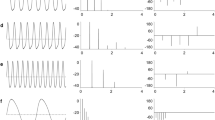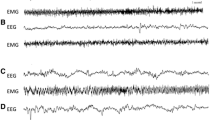Summary
-
1.
Male calling songs of 10 species ofOrchelimum were tape-recorded 9 to 52 times over ranges of ambient temperatures as great as 20 °C.
-
2.
For each species the relation between wingstroke rate and temperature was approximately linear. Calculated regression lines had coefficients of determination (r 2) between 0.76 and 0.99 (aver.r 2=0.93). The slopes of the regression lines varied from 0.9 to 5.1, but when extrapolated downward toŷ=0, the lines tended to converge at 11 °C (x±SD=10.9±1.9).
-
3.
These results are similar to those published for 27 species of crickets and known for 20 additional species of katydids.
-
4.
In previous studies, by others, the effects of temperature on rates within poikilotherm nervous systems have generally been reported asQ 10 values. Such values are appropriate if rates approximate an exponential function of temperature. However, reanalysis of 15 published data sets that were adequate to justify a comparison showed that 13 fit a linear model more closely than an exponential one. Furthermore, if one half a data set was used to predict the other half, the linear model was superior to the exponential model 26 of 30 times. The temperature ranges of the 15 data sets were as small as 12 and great as 26 Celsius degrees.
-
5.
For those 13 data sets with anr 2>0.90, the regression lines tended to converge like those of katydids and crickets. For seven species of electric fish the values ofx whenŷ (discharge rate)=0 clustered about 4 °C (x±SD=4.0±1.8 C).
-
6.
Empirically the linear model is superior to the exponential one in (1) goodness of fit, (2) prediction of effects beyond the temperature range studied, and (3) prediction of data sets from a single or no datum.
-
7.
The origin and slope of the linear regression are generally more useful thanQ 10 values as short-hand expressions of temperature effects on rates in poikilotherm nervous systems.
-
8.
Rates in poikilotherm nervous systems are more complex in their determinants than are rates ofin vitro chemical reactions. It is therefore not surprising that the former rates fail to show the simple exponential relations to temperature that the latter show. On the other hand, that poikilotherm nervous systems should generally have approximately linear relations to temperature and that the extrapolations of linear regression lines should tend to converge at zero rate are unexpected and reveal a need for more study of underlying causes.
Similar content being viewed by others
References
Burkhardt, D.: Die Erregungsvorgänge sensibler Ganglienzellen in Abhängigkeit von der Temperatur. Biol. Zbl.78, 22–62 (1959)
Dumortier, B.: The physical characteristics of sound emissions in Arthropoda. In: Acoustic behavior of animals (ed. R. G. Busnel), p. 346–373. New York: Elsevier Publ. Co. 1963
Enger, P. S., Szabo, T.: Effect of temperature on the discharge rates of the electric organ of some gymnotids. Comp. Biochem. Physiol.27, 625–627 (1968)
Prings, H., Frings, M.: Effects of temperature on the ordinary song of the common meadow grasshopper,Orchelimum vulgare (Orthoptera: Tettigoniidae). J. exp. Zool.151, 33–51 (1962)
Guttman, R., Barnhill, R.: Oscillation and repetitive firing in squid axons. Comparison of experiments with computations. J. gen. Physiol.55, 104–118 (1970)
Heath, J. E., Josephson, R. K.: Body temperature and singing in the katydidNeoconocephalus robustus (Orthoptera, Tettigoniidae). Biol. Bull.138, 272–285 (1970)
Lagerspetz, K. Y. H., Talo, A.: Temperature acclimation of the functional parameters of the giant nerve fibres inLumbricus terrestris L. J. exp. Biol.47, 471–480 (1967)
Morris, G. K., Walker, T. J.: Songs of North American meadow katydids (Orthoptera: Tettigoniidae:Orchelimum). Canad. Entomol.107, in press (1975)
Schwassmann, H. O.: Circadian activity patterns in gymnotid electric fish. In: Biochronometry, p. 186–199. Washington, D. C.: Nat. Acad. Sci. 1971
Spooner, J. D.: The Texas bush katydid-its sounds and their significance. Anim. Behav.12, 235–244 (1964)
Walker, T. J.: The taxonomy and calling songs of United States tree crickets (Orthoptera: Gryllidae: Oecanthinae). I. The genusNeoxabea and theniveus andvaricornis groups of the genusOecanthus. Ann. entomol. Soc. Amer.55, 303–322 (1962a)
Walker, T. J.: Factors responsible for intraspecific variation in the calling songs of crickets. Evolution16, 407–428 (1962b)
Walker, T. J.: The taxonomy and calling songs of United States tree crickets (Orthoptera: Gryllidae: Oecanthinae). II. Thenigricornis group of the genusOecanthus. Ann. entomol. Soc. Amer.56, 772–789 (1963)
Walker, T. J.: Systematics and acoustic behavior of United States crickets of the genusOrocharis (Orthoptera: Gryllidae). Ann. entomol. Soc. Amer.62, 752–762 (1969a)
Walker, T. J.: Systematics and acoustic behavior of the genusCyrtoxipha (Orthoptera: Gryllidae). Ann. entomol. Soc. Amer.62, 946–952 (1969b)
Walker, T. J.: Effects of temperature, humidity, and age on stridulatory rates inAtlanticus spp. (Orthoptera: Tettigoniidae: Decticinae). Ann. entomol. Soc. Amer.68, 607–611 (1975)
Walker, T. J., Whitesell, J. J., Alexander, R. D.: The robust conehead: two widespread sibling species (Orthoptera: Tettigoniidae:Neoconocephalus “robustus”). Ohio J. Sci.73, 321–330 (1973)
Author information
Authors and Affiliations
Additional information
Dr. G. K. Morris, some anonymous referees, Dr. J. E. Lloyd, Dr. J. L. Nation, Dr. D. R. Bentley, and Dr. J. E. Heath gave valuable impetus and help at varied stages of this study. Dr. R. C. Littell contributed to the statistical analyses and Mr. Dana Focks to the computing. A major portion of the research was supported by NSF Grant G-13081. Florida Agricultural Station Journal Series No. 5010.
Rights and permissions
About this article
Cite this article
Walker, T.J. Effects of temperature on rates in poikilotherm nervous systems: Evidence from the calling songs of meadow katydids (Orthoptera: Tettigoniidae:Orchelimum) and reanalysis of published data. J. Comp. Physiol. 101, 57–69 (1975). https://doi.org/10.1007/BF00660119
Received:
Issue Date:
DOI: https://doi.org/10.1007/BF00660119




